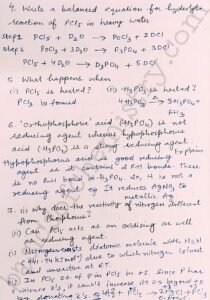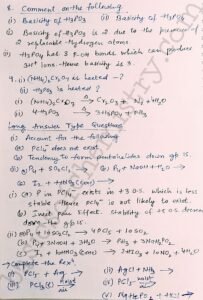P BLOCK ELEMENTS GROUP 15 ELEMENTS CLASS 12 NCERT EXERCISE AND PVQS
Notes on NCERT exercise and PVQS group 15 Elements P block elements Class 12
For explanation of the notes go through the video 👇
P block elements group 15 elements NCERT exercise and PVQS
Important points to keep in mind
In the structure of PCL5 Phosphorus is sp3d hybridization having trigonal bipyramidal geometry and 3 equatorial and 2 axial bonds because of inter electronic repulsions the axial bonds are longer than equatorial bonds therefore all the five P – Cl bonds are not equivalent in PCL5 molecule.
Nitrogen shows less catenation property than Phosphorus because the bond strength between N- N is much weaker than P -P bond strength. The property of catenation is dependent upon the strength of the element element bond.
Pentahalides are more covalent than trihalides because in pentahalides the central atom is in + 5 oxidation State while in tri halides it is in + 3 oxidation state. As higher the positive oxidation state of central atom more will be its polarising power which increases the covalent character between the central atom and halogen.
Bond angle in PH4+ is higher than PH3 because in PH3 molecule there are 3 bond pairs and 1 lone pairs. Due to stronger lone pair bond pair repulsion than bond pair and bond pair repulsion the tetrahedral angle in PH3 decreases from normal tetrahedral angle 109.28 to 93.6. Therefore PH3 is pyramidal in geometry. When PH3 reacts with H+ it forms PH4+ which has no lone pair but four bond pairs so PH4+ assumes tetrahedral geometry. Hence we can say that bond angle in PH4+ is higher than PH3
Hypophosphorous acid is a good reducing agent as it contains 2 P-H bonds but there is no P -H bond in orthophosphoric acid so it is not a reducing agent.
Nitrogen is an inert and unreactive gas at room temperature because the bond dissociation enthalpy of the triple bond present in nitrogen molecule is very high.
PCl5 cannot acts as a reducing agent because the oxidation state of phosphorus in PCl5 is + 5 and phosphorus has five electrons in its valence shell so, it cannot increase its oxidation State beyond + 5 by donating electrons. But PCL5 can decrease its oxidation State from + 5 to + 3 therefore it can act as an oxidising agent.
Acids which contain large number of P-H bonds are good reducing agents therefore as H3PO2 shows the reducing property because of 2 P – H bonds.
For more updates join me on 👇
Website – https://basicsofchemistry.com/
Instagram – https://www.instagram.com/monabindalgupta/
Facebook – https://www.facebook.com/monabindalgupta/
Twitter – https://twitter.com/monabindalgupta
Quora – https://www.quora.com/profile/Mona-Gupta-202
LinkedIn – https://www.linkedin.com/in/mona-gupta-7b450519a



